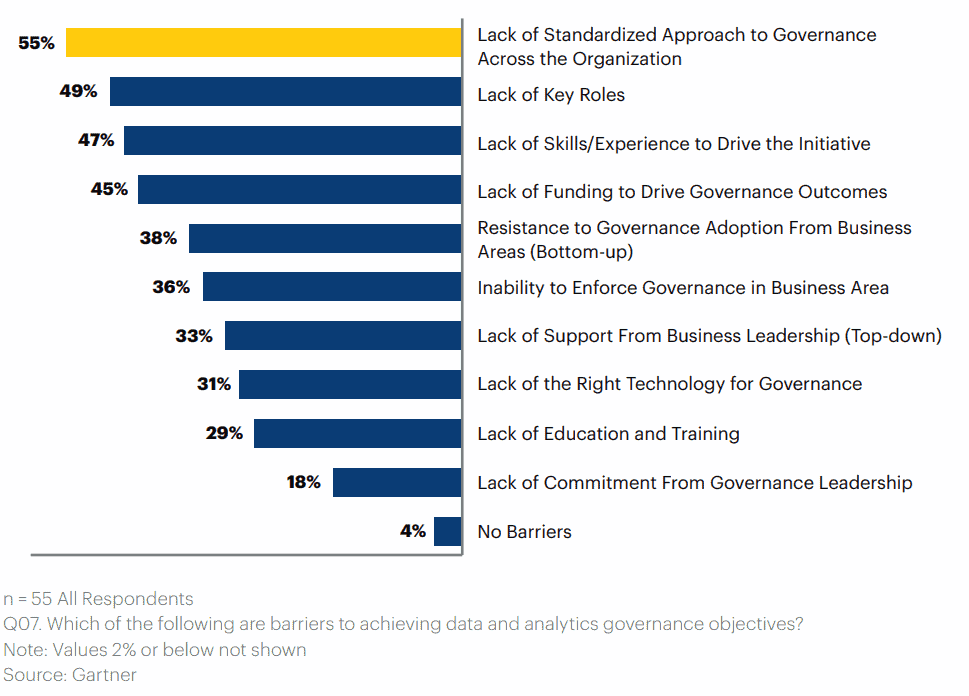Gartner defines data governance as the specification of decision rights and an accountability framework to ensure the appropriate behaviour in the valuation, creation, consumption and control of data and analytics. Barriers remain.
What makes establishing effective data and analytics governance so challenging?

This is important particularly as enterprises pursue a more data-driven approach to how they operate. Achieving a data-driven is likely easier said than done. A Mazars survey of over 1,000 leaders across 21 countries worldwide revealed that 93% have put data as a top (43%) or among the top (50%) priority in their technology roadmap.
While this is very encouraging, only 25% have their data centralized in a shared location and up to 60% do not have processes in place to fix data quality issues at the production stage.

FutureCIO spoke to Hillary Ashton, chief product officer, Teradata for her perspective on how enterprises can master data governance in their journey to become data-driven.
What is data governance in the context of a data-driven organization?
Hillary Ashton: Organizations across sectors—both public and private—are accelerating their digital transformation to develop these experiences. At the heart of this transformation lies the fundamental need to ensure that business objectives are supported by high-quality data and controls across the complete life cycle of data—that framework for achieving this is data governance.
Yet, a global survey commissioned by Teradata reveals that 50% of IT decision-makers worldwide reported that their organizations had no plans to increase data governance investments at this stage; 89% felt their organizations should still prioritize data governance/responsibility initiatives more.
Has the preponderance of tools, experience and expertise, helped improve how organizations manage their data (from creation to destruction)?
Hillary Ashton: Indeed, organizations are leaning on digital tools to improve all aspects of their business operations.
Even though global economic uncertainty has led 87% of companies to rethink their IT investments for 2022 and beyond, 93% of respondents said that when re-evaluating their IT investments, modernizing cloud architecture, improving data management and analytics were among the top investment areas to accelerate their digital transformation efforts.
Where have organizations failed, and continue to fail, when it comes to architecting a data governance strategy that supports transformation?
Hillary Ashton: The main challenge with most organisations is around understanding the importance of a sound data governance strategy and the value that it can drive. It is still seen as a nice-to-have rather than a must-have. It is still seen as an expense that is significant but unnecessary or something that can wait.
Therefore, organisations either keep putting it off or they invest just enough to cover the minimum requirement, ignoring the potential cost of retrofitting data governance systems.
The other key issue is also related to perception. The perception is that data governance slows down the operations in the cloud. This keeps a lot of the start-ups and new organisations born in the cloud from investing in data governance right at the onset.
The larger issue is the lack of education on the topic. Especially the education around the results of not having a good data governance system in place and how much that can cost over time. This is something that organisations tend not to pay attention to and is a big reason for some of the organisations that are behind in this digital age.
What are the top 3 hurdles for future-proof data governance?
Hillary Ashton: Across all industries, data governance is seen as an expense, so even though organizations in Asia recognize that data governance is a very necessary thing, they will only invest just enough and nothing more.
So even though data governance generates value, executives don’t recognize this. For example, data security data governance is 10 to 20 times more expensive to engineer than it is to design, so when decision-makers see the upfront costs, it takes them back. What organizations do not see is that retrofitting data governance, later on, is more expensive and hinders investment.
Another aspect of the problem lies in start-ups. Given that many of these born in the cloud teams build very fast, they often break the chain of governance, as there are no data stewardship policies. Because of their speed, it also costs them a lot to enact a data governance framework. Or so it seems.
They often fail to see that lack of data governance can have even more negative and costly repercussions. `Another reality is that the people that implement governance are not the ones that benefit from a timeline perspective.
Given that technology, regulation and industries/business models change, can you architect a data-governance framework that is futureproof and resilient to change?
Hillary Ashton: A data governance framework exists to support valuable action. By this definition, any anticipated success will need consistent planning and implementation, and the following elements are what makes it resilient to change:
- Identify top-priority, funded business initiatives and the data needed
- Appoint stakeholders to take direct responsibility, in partnership with IT and a federated network of data domain owners and stewards to establish a foundation for implementing highly reusable and cross-functional data to support initiatives.
- Ensure data resources are flexible and scalable, both within the infrastructure, enabled by cloud services, and the design, enabled by careful attention to established architectural principles.
- Work with end-users and application developers to understand common data management struggles and address them within data delivery projects.
- Establish “sandbox” environments with easy-to-use tools that support experimental data provisioning combined with easy access to authorized production data.
The rigour in the application of this framework by appointed stakeholders is by far the most important element for the success of data governance aligned to business initiatives that are expected to achieve business value.
If you think about it, almost every aspect of the business—such as supply chain optimization—requires data for success. Delivering that data, just-in-time, just enough, and in just the right condition to meet the needs of the application and analytical use cases within those initiatives provides not the only justification for data governance, but also provides a built-in scoping mechanism.
Who owns data governance in a digital enterprise?
Hillary Ashton: If we live by the data governance framework, the data domain owners and stewards appointed to establish a foundation for implementing highly reusable and cross-functional data to support initiatives will be the owners.
The difference is obvious given how organizations are approaching modern software architectures, which have created a false sense that data on its own is the solution to achieving business outcomes.
Organizations can’t achieve actionable insights or create satisfying customer experiences simply by storing data in large hardware clusters, collecting data in real-time, or migrating it all to the cloud.
True digital transformation integrates data across the enterprise, but the explosion of data coming from different sources and in different formats—all not necessarily “talking to each other” means that organizations have the opportunity not just to unleash a set of disparate technologies or actions across the enterprise—it all needs to be highly integrated, right down to how we make sense of data.
What can we expect of data governance in 2022?
Hillary Ashton: According to our survey, IT decision-makers globally say emerging technologies are top investment priorities—90% of respondents felt that emergent technologies, such as automation, would have a transformational impact on their organization in the next three years. These include multi-cloud infrastructure, IoT, 5G, edge computing, AI, and data analytics.
Given that all of these are predicated on data—we expect organizations to re-examine how they look at data governance.
Already, we know that 3 out of 4 IT decision-makers agreed that their organization’s digital transformation efforts or lack thereof could be a roadblock to realizing the full benefits of key emergent technologies, such as AI and machine learning, and 82% expressed concerns that not being cloud-ready could be a significant barrier to accelerating their digital transformation efforts.
The thing organizations need to understand is that data governance can accelerate the transformation process, because what they are really investing in is getting the trust and clarity to make better decisions and improving their capacity to address issues like data sovereignty laws, diversity of languages across the region, and more.





